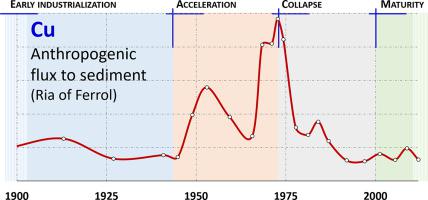Marine Chemistry ( IF 3 ) Pub Date : 2020-05-14 , DOI: 10.1016/j.marchem.2020.103825 Miguel Ángel Álvarez-Vázquez , Paula Álvarez-Iglesias , Elena De Uña-Álvarez , Begoña Quintana , Miguel Caetano , Ricardo Prego

|
This work addresses the study of a sediment core retrieved in the estuary of the Grande-de-Xubia River (Ria of Ferrol), which is among the first industrialized areas in the Iberian Peninsula and has links to the shipbuilding industry since 1750. The chemical analysis of trace elements (i.e. As, Cd, Co, Cr, Cu, Hg, Mo, Ni, Pb, V, and Zn) was coupled with 210Pb dating. The results span a period of about 130 years and cover the whole of the 20th century. Trace element anthropogenic fluxes accumulating in the sediments were calculated and show that human inputs are the most important sources for Cu, Cd, Hg and Zn, being, on average, well over the natural loads. The temporal variation in the anthropogenic contaminants allows the identification of four main phases describing the human-natural input interactions, which in chronological order, are: (i) early industrialization, (ii) industrial acceleration or first industrial transition, (iii) industrial collapse, and (iv) an industrial maturity or a second industrial transition.
中文翻译:

“人类世”期间微量元素的工业供应:费罗尔河地区(伊比利亚西北半岛)河口沉积物的记录
这项工作着重研究了在Grande-de-Xubia河(费罗尔河)河口取回的沉积物芯,这是伊比利亚半岛最早的工业化地区之一,自1750年以来便与造船业建立了联系。微量元素(如砷,镉,钴,铬,铜,汞,钼,镍,铅,钒和锌)的分析与210铅约会。结果跨越了大约130年的时间,涵盖了整个20世纪。计算了沉积物中积累的痕量元素人为通量,结果表明,人类输入是铜,镉,汞和锌的最重要来源,平均而言,它们在自然负荷范围内。人为污染物的时间变化允许识别四个主要阶段,描述人与自然的相互作用,按时间顺序排列:(i)早期工业化,(ii)工业加速或第一次工业转型,(iii)工业崩溃(iv)工业成熟度或第二次工业转型。


























 京公网安备 11010802027423号
京公网安备 11010802027423号